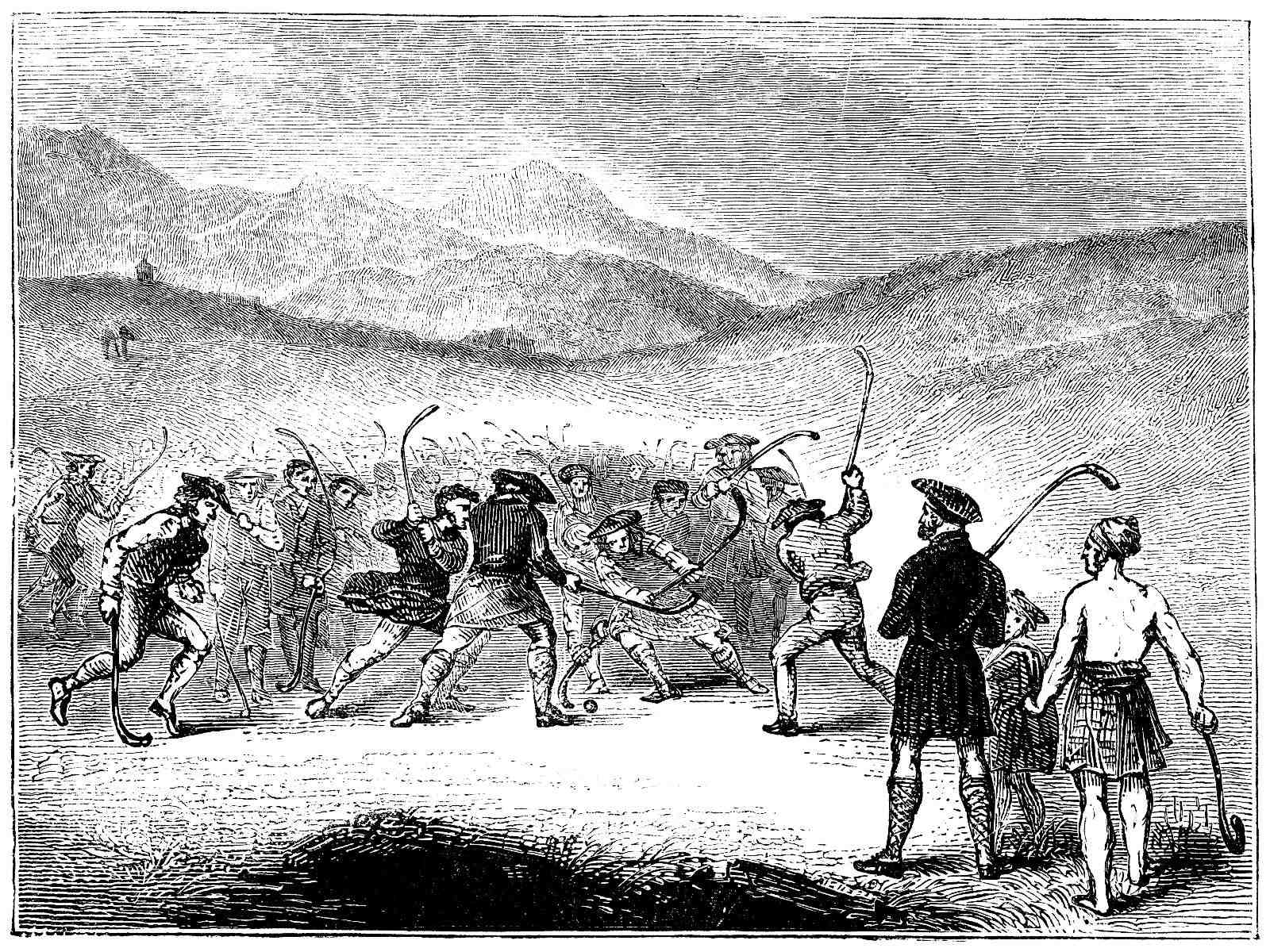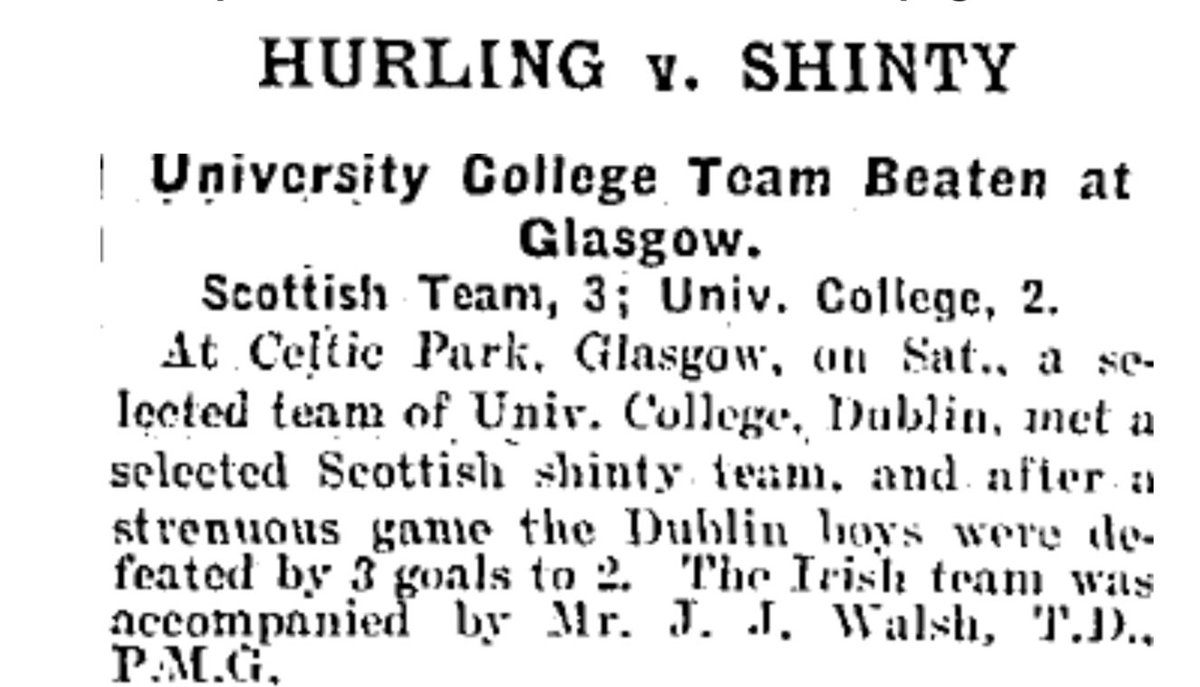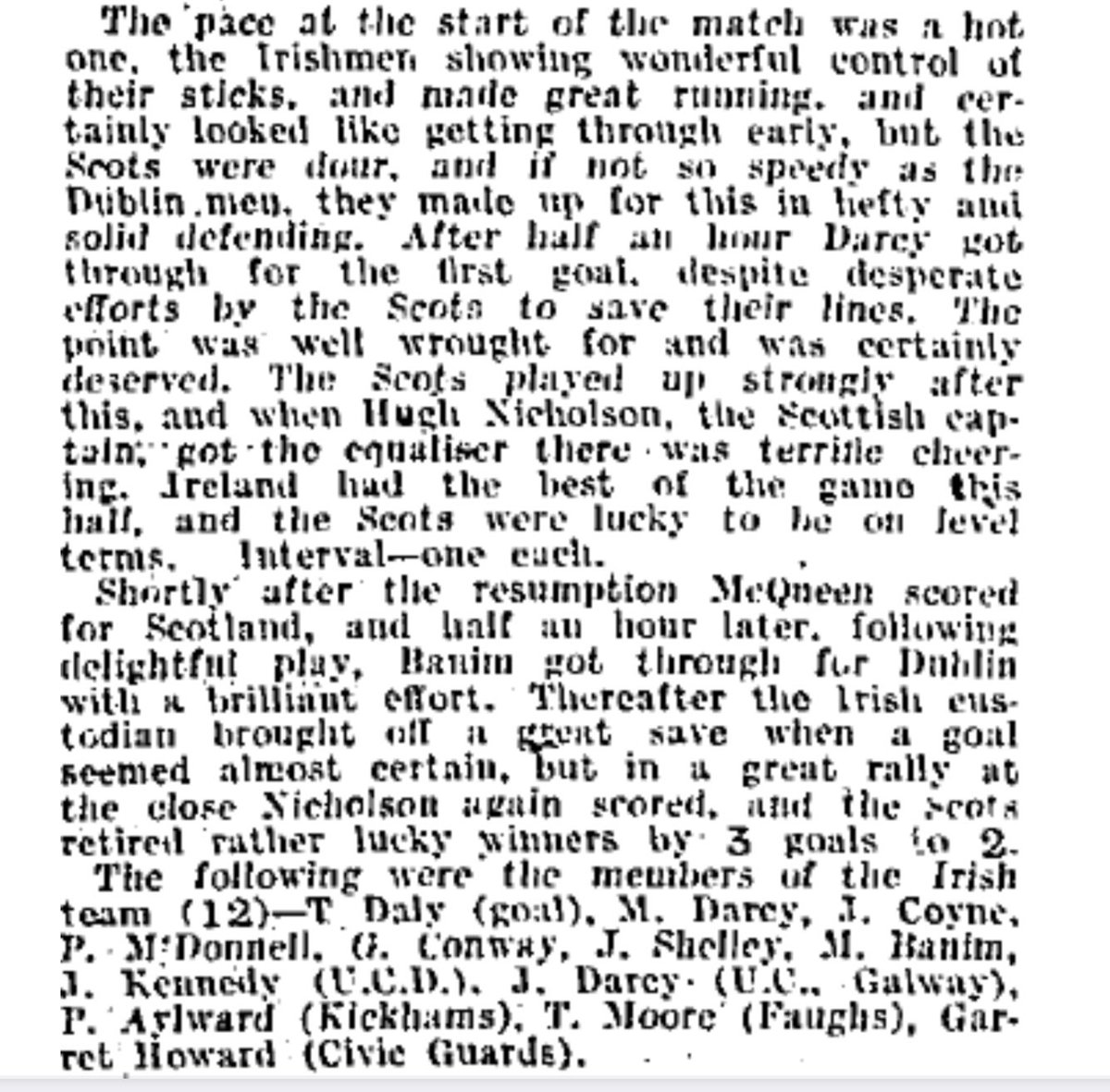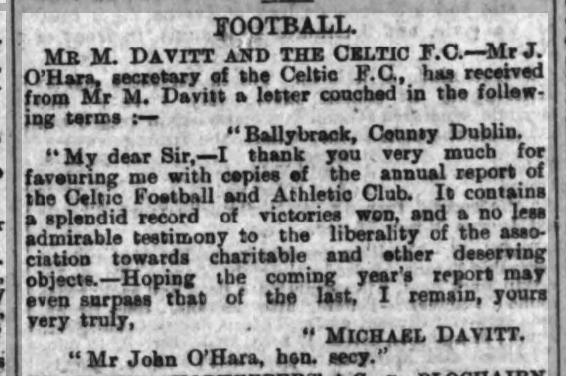Other Sports at Celtic Park | Celtic Park
Details
Ref: Gaelic Games, GAA Games, Hurling, Shinty
Shinty
A close cousin to the Irish game of Hurling, Shinty to outsiders is like a mad version of Hockey. Popular in the Highland areas, it gets scant attention in the Lowlands of Scotland. You’ll more likely find that if any Celtic fans play or follow a version of the game it is more likely by the Hurling rules than the Shinty game.
In any case, there are admirers of the game in the Celtic support, and the club has had the great proud note that Celtic Park played host to the very first composite rules of Shinty/Hurling in Scotland (see below). Another notch on the Celtic post for promoting cross-cultural ties between the Celtic nations.
Notably, during the Irish Flag crisis (1952), Celtic’s apparent response to being ejected out of the league: “Fine then, we will simply play gaelic football“!
Additionally of note, there is a famous ‘Celtic’ in shinty: ‘Oban Celtic‘. Apparently, their name came about by chance. The name was decided upon by the mere toss of a coin, the other option being Rangers. It is noted by the rest of us that most Oban Celtic players actually supported the old Rangers FC (now dead). The club had sometimes played in green and white hoops, but this has not been the practice for a few years, and their main strip is currently Green & White stripes.
1893 Match
A match was played at Celtic Park between two top Hurling sides on Saturday 9th September 1893, “The Great Hurling Match between teams comprising the Champions of Ireland”.
The two sides were from Dublin: Brian Boru and Dublin Celtic (referred to as All Ireland elsewhere).
The final scoreline was 7 goals to 6 goals & 2 points in favour of Brian Boru. The match was said to be interesting and exciting.
(fuller details can be found in the book “Celtic: The battle for the club’s soul” by Brendan Sweeney on p.180-181)

1897 match
Celtic Park hosted the first ever Composite rules Shinty/Hurling match held in Scotland in 1897, this was between Glasgow Cowal and Dublin Celtic.
(note some records claim this match was on 11 Apr 1897 and not in May 1897 as the article claims).
(match report)
In Ireland, in May 1897, it was reported that “the final preparations” for a fixture between Dublin Celtic and Glasgow Cowal in Glasgow were complete. Rules were set and colours chosen for a match reported as “the first between Irish hurlers and Scottish shinty men on Scottish soil”. The Celtics left Dublin on Friday evening by the Dublin Life Boat.
This game, which was being looked forward to with much interest by Highlanders in Glasgow, took place on the Saturday afternoon at Parkhead, by kind permission of the Celtic Football Club.
“Each combination wielded sticks peculiar to their respective countries. Those of the Irishmen resembling elongated bats. A number of the Irishmen played in their bare feet. Mr. MacFarlane, Oban, ex-president of the Scottish Shinty Association acted as a referee. There was a big crowd of spectators, amongst whom were many well-known Highlanders!“
The Scots made a stunning start to the game and led 8-0 at the interval, with David Chisholm scoring seven of them. A larger size of ball, and one similar to that usually played with in hurling games, was brought out in the second period, and the advantage to the Irishmen was immediately evident. They had, however, to concede defeat in the end by 11 goals to 2.
At the close three cheers were raised by the defeated team for the victors, and were returned by the victors for the losers. The teams and officials of the clubs were afterwards photographed. After the match the members of the Dublin team were entertained to dinner by the Cowal men.
The first combined shinty/hurling match 1897
Fad air ais ann an ceò na h-eachdraidh, thàinig laoch a dh’Alba a Eireann. Le tri ceumanan mòra, thàinig e na chruinn-leum bho fhaicheanan na h-Eireann Chun Eilein Sgiathanaich. Crochte ri gach sliasaid agus e na shiubhal bha ceithir fichead neach : ceithir fichead eile air gach gàirdean: naoinear eile gan toinnemh na fhalt. Thàinig e a dh’Alba ga fhòghlam air altruim còmhla ris a’ Bhànrigh Sgàthach; a dh’ionnsachadh armachd agus gaol. Mar thiodhlag, thug e an gèam camanachd do mhuinntir na h-Alba.
Way back in the mists of time, a hero came to Scotland from Ireland. With three massive steps, he came bounding over from the green swards of the Emerald Isle to the Isle of Skye. Hanging off his thighs and travelling with him were 80 other people: 80 more on each arm; nine more spinning in his hair. He came to Scotland to compete his education as a fosterling with the Warrior Queen Sgathach; to learn to battle and love. As a gift in return, he gave the game of shinty to Scotland.
The common heritage – the mythical part at any rate – of shinty and hurling can be traced back 2,000 years. The parting of the ways came much more recently when both were formally codified. The establishment of shinty’s ruling body the Camanachd Association (1893) and the Gaelic Athletic Association in Ireland (1884) should be seen in the context of prevailing conditions in two quite separate and distinct environments.
In Ireland, the great mass of the people had been demoralised throughout the years of colonialism and particularly as a consequence of the Great Famine of the 19th century. The Famine had destroyed everything and hurling suffered a disastrous decline in the decades following Irish famines of the late 1840s.
In Scotland the impact of the Clearances was severe also, but remarkably, towards the end of the century, there was an element of cross-fertilisation between the two stick codes. A frenetic rash of activity culminated in the first ever shinty/hurling “international in Glasgow in 1897.
That this event ever took place was due in no small part top two key people, John Murdoch in Scotland and Michael Cusack in Ireland, both of whom were involved with newspapers, the Highlander in Scotland and The Celtic Times which was a unique venture in Irish sporting journalism, running for the whole of the year 1887.
In that year Cusack donated the Celtic Times Challenge Cup for an annual hurling versus shinty game which is understood to have taken place intermittently in Dublin at least up to 1919.
There was clearly some engagement between Scots and Irish in various places in the 1880s but the real resumption of links between Ireland and Scotland towards the end of the 19th century seems to have come about in the aftermath of the formation of the Camanachd Association in 1893. The impetus as far as shinty was concerned came from the cities of Glasgow and London.
On Boxing Day in 1896 at Lea Bridge in London, the most attractive event of the day was a hurling match between a team selected by the County Board and a team from the London Scottish Camanachd Club which lay some claim to “international” status, ending up Ireland 3; Scotland 0.
This was the forerunner of the great event.
In Ireland, in May 1897, it was reported that “the final preparations” for a fixture between Dublin Celtic and Glasgow Cowal in Glasgow were complete. Rules were set and colours chosen for a match reported as “the first between Irish hurlers and Scottish shinty men on Scottish soil”. The Celtics left Dublin on Friday evening by the Dublin Life Boat.
This game, which was being looked forward to with much interest by Highlanders in Glasgow, took place on the Saturday afternoon at Parkhead, by kind permission of the Celtic Football Club. “Each combination wielded sticks peculiar to their respective countries. Those of the Irishmen resembling elongated bats. A number of the Irishmen played in their bare feet. Mr. MacFarlane, Oban, ex-president of the Scottish Shinty Association acted as a referee. There was a big crowd of spectators, amongst whom were many well-known Highlanders!”
The Scots made a stunning start to the game and led 8-0 at the interval, with David Chisholm scoring seven of them. A larger size of ball, and one similar to that usually played with in hurling games, was brought out in the second period, and the advantage to the Irishmen was immediately evident. They had, however, to concede defeat in the end by 11 goals to 2.
At the close three cheers were raised by the defeated team for the victors, and were returned by the victors for the losers. The teams and officials of the clubs were afterwards photographed. After the match the members of the Dublin team were entertained to dinner by the Cowal men.
It was immediately reported that a return match was to be played in Dublin on Glasgow Fair Saturday, July 17. This was played in Dublin as scheduled, in front of a poor attendance in “oppressive weather” at the City ground on Suburban Road, Jones Road. The Irish were said to have “made a fair show against the Glasgow men considering the fact that they had never before tried their luck at the game”.
The referee was none other than Michael Cusack and Cowal again won, by a reduced margin of two goals to nil.
The difference in the scale of Scotland’s victory between the two games has been a mystery which can now be clarified. As the second game was fixed for the Glasgow Fair Holiday, six key Cowal players decided that they would head for Argyll rather than Dublin!
The match was also to be played 15-a-side instead of 12 as in Glasgow, due to the bigger pitch. All this taxed Cowal’s resources. The match was reported as one of the most exciting games of shinty or hurling that has ever been seen in Dublin.
The irony was that it was to be another 27 years – in 1924 – before a great game would be played between Irish and Scottish hurlers on Irish soil. By then Ireland itself, never mind camanachd, would be very different.
Thankfully the links established in the 1880s have survived and Ireland now meet Scotland in international challenge matches at a number of levels, including a women’s match. One wonders what the great hero himself and the Warrior Queen Sgathach would have thought of it all.
Written by: Hugh Dan MacLennan
1913 match
Scotland and Ireland clashed at Celtic Park on June 21st 1913 in a match organised by the Gaelic Athletic Association (GAA). Ireland were represented by All Ireland champions Kilkenny while Scotland were made up of a select side featuring the best players from clubs in Glasgow, Lanarkshire and Renfrewshire.
(from ‘sports historian’ search)
Gaelic athletic clubs in Scotland became closely linked with the Gaelic League, indeed, members of the League often founded them. At the turn of the century this was already a thriving organisation in Scotland with seventeen branches in the Glasgow district as well as in Paisley, Blantyre, Motherwell, Hamilton, Wishaw, Coatbridge, Carfin, Renton, Kilsyth, Barrhead, Denny, Johnstone, Dumbarton, Ayr, Port Glasgow and Greenock.
As G.A.A. clubs emerged in Scotland hurling, as opposed to Gaelic football, dominated. Although players with no hurling background played the game, at the time there were also a number of skilled hurlers involved. This is clear from contemporary reports. Indeed, a recognition of the skills of the ex-patriot hurlers in Scotland came in 1913 when Glasgow played host to the previous winners of a number of All-Ireland Hurling titles, Kilkenny. The match took place at Celtic’s stadium in front of a crowd of five thousand people and the Scottish representatives were beaten by a score of ten goals and five points to four goals and two points.
This game was viewed as having the potential to promote the sport amongst the Irish in Scotland but its prospects were hampered when the occasion met with competition. On the same day, at Coatbridge in Lanarkshire, the annual demonstration of the Irish National Forresters took place. This friendly society, which also incorporated nationalist and Irish cultural identities, contained branches all over the west central belt in which many Catholic families had members attached. Many thousands of Irish Catholics attended this particular demonstration.
1924 Match
(below info thx to Cork Hurling History @HurlingHistory)
On the 17th of May 1924, a team from University College Dublin (@UCDGAA) clashed with a Scottish shinty selection side in a game of shinty at Celtic Park in Glasgow.
The @UCDGAA men were beaten by 3 goals to 2 goals despite the team containing such greats as Dr. Tommy Daly of @GaaClare and @DubGAAOfficial , Garrett Howard of @LimerickCLG and @DubGAAOfficial and Tommy Moore of the @FaughsGAA.


Links
OLD IRELAND’S PRIDE
(from GAA News 3 Aug 2012, see: http://www.gaa.ie/gaa-news-and-videos/daily-news/2/0208121423-sideline-snippets-week-10/)
The current Kilkenny team are widely regarded as one of the greatest, if not the greatest, hurling team of all time.
But from 1907 to 1913, the Cats also had an all-conquering team which won five All-Ireland titles in that period, including three in a row from 1911-1913.
So dominant was that team, that they were chosen to represent Ireland in a hurling international against Scotland at Celtic Park in 1913, as this picture shows.
The ‘Kilkenny’ insignia can clearly be seen on the players’ jerseys as they pose with their hurls. The inscription below the photograph reads as follows:
“Today, Saturday June 21st, a great international hurling match, Ireland v. Scotland, takes place at Celtic Park, Parkhead. The Scottish side will consist of Irish exiles chosen from the leading hurling clubs of Glasgow, Lanarkshire and Renfrewshire.
“Ireland will be worthily represented by the Kilkenny team, All-Ireland champions. Hurling, or caman, is of course, the immemorial national pastime of Ireland, dating back to the legendary days of Finn McCool. Before the game, the picturesque parade takes place, the teams in military style marching round the field to the stirring strain of an Irish war-pipe band.”
The headline on the picture reads: “OLD IRELAND’S PRIDE – KILKENNY CHAMPIONS HURLERS IN GLASGOW”
As Kilkenny now find themselves back in the All-Ireland semi-final, and chasing a sixth All-Ireland title in seven years, it appears that little has changed in 100 years when it comes to hurling dominance.


Michael Davitt
Biog: https://www.thecelticwiki.com/about-celtic/celtics-foundation/michael-davitt-patron/


